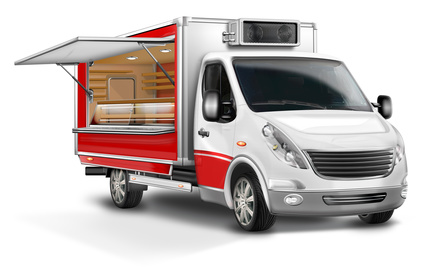This post is also available in:
 English
English  Français (French)
Français (French)  Deutsch (German)
Deutsch (German)
Business location for starters – the Problem We think there is a lot of money to be made with a mobile snack stand, a food truck and other sales vehicles. Additionally it is not only making money: it is fun to prepare and selling food and drinks.
For example, independent sausage sellers in their food trucks and carriages on the Freiburg Münsterplatz are estimated to have a six-figure annual income per car. These people endure the market in cold and hot weather and most of them do not have to publish balance sheets. There are therefore no generally available figures on the income from sausage sales, it must be estimated.
The following article contains a model calculation to determine the expected profit with a food truck or trailer. Advertising and the very important factor “sales per customer” are taken into account.
If the dream of your own food truck or trailer is to become a reality, you need a wagon and one or more selling places. When researching a truck, I will quickly come across offers from franchisors. At first glance, at least to me, these look new and inspire me very soon. After the first impression, I just want the car.
The smart entrepreneur thinkss: “First check the calculation”. The sample calculations submitted by franchisors could be daring and presented very nicely. The realistic scenario is possibly hidden between airier calculations. Speculatively high assumptions about workloads create unrealistic high earnings.
A serious seller does not lie, he arranges the facts nicely. A simple trick to make things beautiful but not wrong bases on the fact that people love the middle. We intuitively think the middle scenario is realistic, the left one is bad and the right one is so good, that it will not happen. And already we are in the mental trap. The scenario in the middle is in reality the extreme upwards. The very good case shown in the “good” column of the sample calculation, usually on the left, cannot be achieved.
The formula for the financial success of mobile sales stands and food truck
Here is a formula that is simple and works well. Some market research is necessary for some of the necessary information, I just give estimated figures.
Lets start with the sales volume.
The turnover U is calculated from the number of passers-by n, the purchase probability for each passer-by p (p) and the turnover per buyer u (p). So daily turnover = n * p (p) * u (p). We see 500 passers-by every day. Of those, 10% buy. Everyone makes a turnover of 5 €. This results in a daily turnover of 500 * 0.1 * 5 = 250 €. That is not much, as we shall see later.
The costs add like that:
Daily costs = stand rental + purchase price of the car / service life in days + maintenance costs + energy costs + labor costs + cost of goods + advertising other ancillary costs.
Fixed costs: stand rental, depreciation, wage costs (fixed jump)
Variable costs: maintenance, energy, labor costs, goods
Example:
A food truck or trailing carriage with the same purpose has space rent of € 30 per day, depreciation is € 25 per day, energy costs € 10, maintenance € 5, our minimum wage worker costs € 100 per day including social security contributions and vacation. We make € 250 in sales every day, the cost of goods is 40% of sales. Taken together, this results in a daily loss of € 20. What to do? The employee complains about stress and how much he has to do.
We check what the employee is actually doing. He needs three minutes per customer and has 480 minutes a day, of which he needs 45 minutes for preparation and cleaning. That equates to 435 minutes for the customer – with three minutes per customer that’s 145 customers a day. Nobody can serve customers quickly and permanently for 8 hours at a time. There are also times of weak demand. We therefore assume a maximum utilization of 50%. That would be 72 customers every day. So far we have had 50 customers a day. So the employee could do a little more.
We decide to do a promotion. This costs 30 € daily and brings 20 customers daily. The turnover increases to 350 € per day. Previous costs + advertising + more cost of goods = new costs.
270 € + 30 € + 40 € = 340 € costs, 350 € income, we finally earn a little. But not enough to cover our entrepreneurial risk. We want 15% of sales, € 10 per day is just over 3%.
We achieve the 15% minimum profit with a slight increase in customer sales to € 5.5. With 70 customers, this equates to a daily turnover of € 385, the costs then amount to € 324 per day.
The number of customers matter
Mobile food trucks and trailers are a a business of big numbers. Additionally it has some similarties to real estate business: location is everything. In addition, a clever price and product policy. This increases sales per customer. He is offered what he wants and his wishes are addressed. Franchise concepts must be checked to see whether they allow an increase in customer sales. In addition, the sales time per customer must be low. The sausage barons can serve a customer in less than a minute and generate € 2.20 in sales.
More revenue per customer
Here, high sales per customer combined with mass business lead to the desired profit. The sales car must offer enough space for this.
Sidelining with a food truck
If you think help helps you:
I have another article about finding a good place for the carriage /food truck.
finding a place professionally (German)


